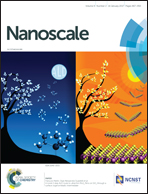Nanoporous carbon derived from a functionalized metal–organic framework as a highly efficient oxygen reduction electrocatalyst†
Abstract
High levels of iron–nitrogen doped porous carbon materials are obtained from MOF-253 using a step-by-step post-synthetic modification strategy. MOF-253 possessing open 2,2′-bipyridine nitrogen sites not only serves as a precursor but also provides chelate bonding sites for Fe2+. Followed by further impregnation of 1,10-phenanthroline, high surface area porous carbon materials are obtained. For comparison, when iron-1,10-phenanthroline species as a whole are incorporated into MOF-253, carbon materials with less active sites and low surface area are obtained. The porous carbon materials derived from MOF-253 by using a step-by-step post-synthetic modification strategy demonstrate excellent ORR activity, high selectivity (direct 4e− reduction of oxygen to water) and stability under both alkaline and acidic conditions. The onset potential of the porous carbon material under alkaline conditions (980 mV) is the same as that of Pt/C (20 wt%) (980 mV) and the half-wave potential (E1/2) is 840 mV, which is 20 mV more than that of Pt/C (20 wt%). Under acidic conditions, the onset potential and the half-wave potential are only 20 mV and 30 mV less than those of Pt/C (20 wt%). The developed step-by-step post-synthetic modification route of MOFs has expanded the ways to prepare functionalized porous carbon for energy related applications.



 Please wait while we load your content...
Please wait while we load your content...